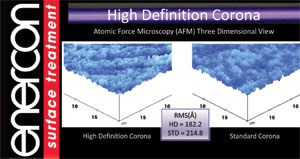Advanced Techniques for Analyzing Surfaces
Dec 12th, 2008 | By kmaier@enerconmail.com | Category: Did you know? What does surface treatment really do to a surface? You can find out by taking advantage of specialized technologies for analyzing the effectiveness of surface treatment.
What does surface treatment really do to a surface? You can find out by taking advantage of specialized technologies for analyzing the effectiveness of surface treatment.
X-ray Photoelectron Spectroscopy (XPS) is a quantitative spectroscopic technique that measures the elemental composition of the elements that exist within a material.
Applications:
- Metal surfaces
- Treated surfaces
- Chemically modified surfaces
- Polymeric samples
- Silicone contamination
- Inorganic surfaces
- Adhesion problems
- Failure analysis
- Competitive product analysis
- Deformulation
Atomic Force Microscopy (AFM) is an analytical tool used to measure nanoscale differences in modulus and height of materials in the nanoscale size range.
The primary uses are to characterize either nano-phase morphology or surface roughness. It is also an excellent tool for the analysis of the phase morphology of microphase separated block copolymer systems or other nanoscale products.
Applications:
- Surface roughness
- Phase separation
- Surface aging studies
- Nano-particle dispersion
Scanning Electron Microscopy (SEM) scans surfaces with a high-energy beam of electrons to create a variety of signals which reveal topography data.
Applications:
- Lubrication
- Coatings
- Ceramics
- Metals
- Composites
- Adhesion
- Photovoltaics
- Corrosion
These technologies are offered as an extension as Enercon’s free atmospheric plasma treating laboratory. Please follow the links for more information on free laboratory testing for plasma treatment of webs and the plasma treatment of objects.
